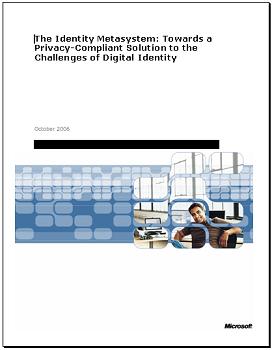Microsoft has just completed a whitepaper that looks systematically at how the proposal for an Identity Metasystem advances privacy.
The document offers a useful general overview of how the Metasystem is intended to work – in a form I think will be accessible to those concentrating on policy. It also contains an instructive analysis of how the Metasystem embodies the principles articulated in the European Uniion data protection directives.
I will run some exerpts that I think will be of general interest. But I suspect all those interested in policy and identity technology will want to download the document, so I've added it to the roster of Identityblog white papers.
 Introduction
Introduction- Existing ID Card Schemes
- Anonymity, Privacy, and Security
- The Identity Metasystem
- The Seven Laws of Identity
- Roles
- Microsoft’s InformationCard Technology: Windows CardSpace
- Scenario One: Basic Protocol Flow
- Scenario Two: Protocol Flow with Relying Party STS
- User Experience
- Creating an Information Card
- Logging In with an Information Card
- Submitting an Information Card
- Example of InformationCard Interaction
- Privacy Benefits of Windows CardSpace and the Information Card Model
- Protection of Users Against Identity Attacks
- Information Card Technology and EU Data Privacy
- Overview of EU Data Privacy Law
- Data Controllers and Their Legal Obligations
- EU Data Privacy Laws and Information Cards
- Legitimate Processing
- Proportionate Processing
- Security
- Limits on Secondary Use
- Conclusion
- Acknowledgments
From the Executive Summary:
Microsoft believes that no single identity management system will emerge and that efforts should instead be directed toward developing an overarching framework that connects different identity systems and sets out standards and protocols for ensuring the privacy and security of online interactions. Microsoft calls this concept the Identity Metasystem. The Identity Metasystem is not a specific product or solution, but rather an interoperable architecture that allows Internet users to use context-specific identities in their various online interactions.
This paper describes the Identity Metasystem and shows how it can meaningfully advance Internet user privacy. In particular, it will show how Microsoft’s contribution to the engineering of the Identity Metasystem—the Information Card technology—promotes privacy in three primary ways:
- First, it helps users stay safe and in control of their online identity interactions by allowing them to select among a portfolio of digital identities and use them at Internet services of their choice. These digital identities may range from those containing no or very little personal information (perhaps nothing more than proof of an attribute such as age or gender) to those with highly sensitive personal information needed for interacting with financial, health institutions, or obtaining government benefits. The key point is that a web site or service only receives the information it needs rather than all of the personal information an individual possesses.
- Second, it helps empower users to make informed and reasonable decisions about disclosing their identity information by enabling the use of a consistent, comprehensive, and easily understood user interface. Moreover, this technology implements a number of advanced security features that help safeguard users against identity theft by reliably authenticating sites to users and users to sites.
- Third, and more generally, Information Card technology is hardwired to comply with data privacy laws and conforms to key requirements in the European Union’s privacy regime, including legitimate and proportionate processing, security, and restraints on secondary use.
In short, this new framework and new technology offer a cutting-edge solution to the digital identity debacle that is stifling the growth of online services and systems.
I want to congratulate Ira Rubinstein, Internet Policy Counsel for Microsoft, and Tom Daemen, a senior attorney in his group, for writing this analysis. Other contributors include our Chief Privacy Stragegist, Peter Cullen, and Caspar Bowden, Chief Security and Privacy Officer for Europe. Not to mention the inimitable Mike Jones, well known for his contribution to Identity Metasystem thinking.
Although the document uses the Cardspace implementation in illustrating its points, it's my hope that everyone working on the Identity Metasystem across the industry benefits from this work, since the notions apply to all of us.

4 thoughts on “Privacy characteristics of the Identity Metasystem”
Comments are closed.